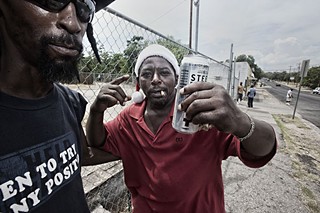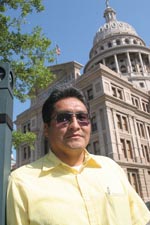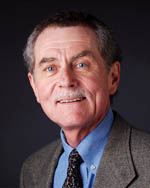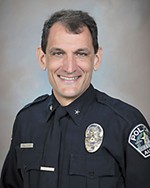Working 'The Corner'
Neighbors and officials plan one more effort to save the neighborhood around 12th and Chicon
By Jordan Smith, Fri., July 13, 2012
(Page 2 of 3)
Weeding Without Seeding

There was a time when 12th and Chicon was at the center of the Eastside universe, a vibrant hub for the city's African-American community, a place where arts, commerce, and daily living fit seamlessly together. "We used to be self-sufficient in East Austin," says Ivory. "The only time we needed to go to Congress Avenue was to buy shoes or clothing." Those days are gone. Although the city finally got around to paving streets here in the late Sixties, many of the businesses began to close as the city moved to desegregate, and the old neighborhood began to lose cohesion.
Now, there isn't much left. There's a "prayer cafe" operated by the Mission: Possible! ministry, where, when volunteers are around and the place is open, a person can go and pray in exchange for a cup of coffee. There's a liquor store on Chicon, a small pool hall (rumored to host a robust backroom gambling operation) across the street, and a couple of clubs (including the Legendary White Swan) along the north side of East 12th on either side of Chicon. There are barber shops and Galloway's Sandwich Shop, just west of Sam's BBQ. There are plenty of people around, making the street look more prosperous than it is. And there is a sort of prosperity, if you include the drug dealers – some of whom live in the area, but many more come here to work, making a daily commute like thousands of other Austinites.
Indeed, the area does have a serious drug problem, say Austin police and many residents and other community stakeholders. Most of it operates in the open along both sides of Chicon, north of 12th Street, spilling into the alley between East 12th and 13th. People gather here in all weather and at all times of the day and night, selling or buying primarily crack cocaine and marijuana, says APD Sgt. Robert Jones, who supervises the Central East Metro Tactical Unit that leads most of the drug sting operations in the area. Jones has been working in this neighborhood for most of the 17 years he's been with APD, and he believes that although progress is slow, things have actually gotten better over that time. The open-air drug dealing and related crime, he says, "has decreased over time; however ... if I lived in that particular block, I would not be satisfied with the rate of change."
There have been many attempts to speed things up. For years police have done sting and long-term undercover drug operations here; they've netted many arrests but generated no long-term change. There was the Central East Austin Weed & Seed Initiative, a federally underwritten effort to reduce crime, improve social services and other community resources, and concentrate community policing efforts, in order to maintain police visibility and strengthen the community-police partnership.
Whether Weed & Seed had any positive effect on 12th and Chicon depends on whom you ask. There were plenty of "weeding" arrests, but not so much "seeding" – at least as Robert Love sees it. Love, a former addict who has worked with HIV-positive and drug-addicted people for nearly two decades, is quite familiar with the dynamics of 12th and Chicon, where he used to run the county mental health service agency's Community AIDS Resources and Education drop-in center a half-block north of The Corner. For five years, he and the CARE center were a resource for the drug users in the area, a place where they could come for HIV testing, drug-treatment referrals, a cup of coffee, a clean bathroom, and the friendly ear of someone like Love, who worked hard to get people off the corner by connecting them to the social services that would help them to do so. "We got a lot of people tested and into [drug] treatment and referrals" for other services, he says.
That ended, however, when Weed & Seed started. After a wrangle between the APD and the county's mental health provider (now Austin Travis County Integral Care), the drop-in center was shut down. "The [police] said we were attracting all the addicts, that we were part of the problem" at The Corner, Love recalls. Love strongly disagrees; the reason the drop-in center was located there, he insists, was because that's where the need was – and even after Weed & Seed burned out (the program was eliminated earlier this year), that's still true. "The issue there is they really don't have any services," Love says. "They get stuck on that corner and can't seem to get out of it." The CARE program moved to East Second Street, but the addicts from 12th and Chicon have not followed, Love says.

The policing statistics remain dispiriting. Consider this: In a recent three-week operation, Jones' officers arrested 35 individuals for drug dealing at 12th and Chicon; collectively, those 35 people had been charged with roughly 3,000 crimes over the course of their criminal careers. Whether any of them will be off the street for long isn't clear – even to Jones. "Repeat offenders are arrested on a regular basis," he says, cycling in and out of jail and back to the street, regardless of the severity of their offenses.
In a recent sting, one of Jones' officers bought drugs from a dealer on The Corner; when the cop went to arrest the man, he ran down the alley. Officers chased him and had to use a Taser to get him under control and arrested; the very next day, police caught him slinging dope again. After another undercover buy, the man again ran, this time fighting with officers before being taken into custody. "Is it frustrating? Very much so," says Jones. In 2011, police made a total of 610 arrests for 939 offenses at and around the intersection of 12th and Chicon; in the first six months of this year, they've made 251 arrests – including many of chronic offenders – for a total of 376 offenses.
The situation frustrates many neighbors, says Keri Slater. "I love my neighbors, I love my neighborhood. ... It's the most diverse place you can live in Austin," she says. "If [there were this many arrests] for drugs or prostitution in Hyde Park," something would be done, and quickly, she believes. "If somebody wanted to do something about [12th and Chicon], they would've [already]." Sherman and others point Downtown – there, when an open-air drug market took hold in 2009, neighbors rallied and D.A. Lehmberg responded, instituting the swift justice of enhanced prosecution to close down the dealing. If that approach is good for Downtown neighbors, he wonders, isn't it good for Central East neighbors too?
Finding Another Way
In December 2011, the Austin American-Statesman reported the success of the 5th Street Community project, and Lee Sherman took notice. He contacted community activist Madge Whistler, asking her if she thought that enhanced prosecution could work at 12th and Chicon and how, exactly, the Downtown neighbors achieved their goal of shutting down the open-air drug dealing so quickly. Work with your beat cops, Whistler told him – "because they're the people who are going to make a difference for you every night out" – and work with your neighbors. Those relationships, she says, were the keys to the project's success. And she told him she believed the success of the 5th Street Community would be replicable in neighborhoods all over the city.
However, a crucial difference in the Fifth Street and 12th and Chicon situations is the nature of the two neighborhoods and therefore the impact of the drug scene. Downtown, the dealers and their customers were almost exclusively considered outsiders by the residents, themselves mostly relative newcomers to the neighborhood. But 12th and Chicon is embedded in an Eastside neighborhood with a historically ambivalent relationship with police and public officials. The drug market itself includes both hardcore criminals and neighborhood residents caught up in the life for lack of other opportunities and resources. As a result, addressing the problem would seem to require both a more nuanced and more comprehensive approach than simply more arrests and prosecutions, "enhanced" or otherwise.
In that context, Lehmberg thinks there may be a better way to address the chronic problems at 12th and Chicon. She'd like to try the High Point Drug Market Intervention program developed in North Carolina (in part by former APD Assistant Chief Jim Fealy), which has been used across the country with impressive results. The Corner is "pretty clearly an open-air drug market. And you know, one of the things I've been told by so many people, including the police, is 'we have tried every initiative – we've had stings, we've had special operations, we've had everything,'" and yet the problems persist. "That's one of the reasons I started looking at the High Point solution, because it is specifically marketed [to combat] open-air drug dealing, and it has had a lot of success. ... I mean, there's nothing about High Point that isn't enhanced prosecution; it's just got a different name." And a different, more nuanced, approach.
Got something to say on the subject? Send a letter to the editor.










